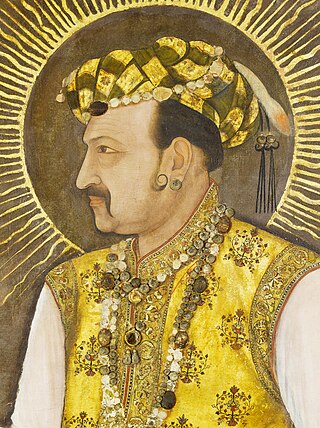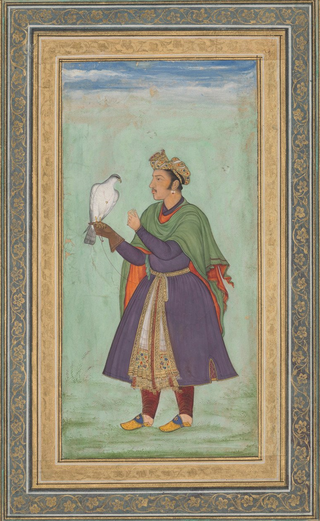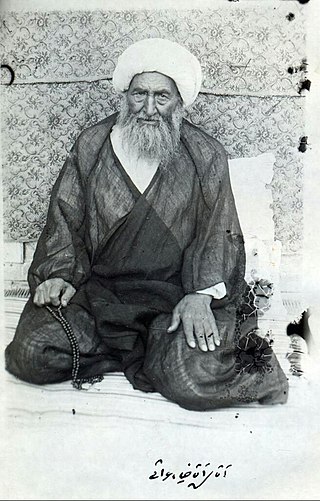Related Research Articles

Nur-ud-din Muhammad Salim, known by his imperial name Jahangir, was Emperor of Hindustan from 1605 until his death in 1627, and the fourth Mughal Emperor.

Mirza Shahab-ud-Din Muhammad Khurram, commonly called Shah Jahan I, also called Shah Jahan the Magnificent, was Emperor of Hindustan from 1628 until his deposition in 1658. As the fifth Mughal emperor, his reign marked the zenith of Mughal architectural and cultural achievements.

Muzaffar al-Din Jahan Shah ibn Yusuf or Abu al-Muzaffar Jahan Shah was the leader of the Qara Qoyunlu Oghuz Turkic tribal confederacy in Azerbaijan and Arran who reigned c. 1438 – 1467. During his reign he managed to expand the Qara Qoyunlu's territory to its largest extent, including Eastern Anatolia, most of present-day Iraq, central Iran, and even eventually Kerman. He also conquered neighbouring states. He was one of the greatest rulers of the Qara Qoyunlu. He was also allegedly fond of drinking and entertainment. During his reign Jahan Shah had the Gökmedrese and Muzafferiye theological schools constructed in his capital city Tabriz.

Khusro Bagh is a large walled garden and burial complex located in muhalla Khuldabad, close to the Prayagraj Junction railway station, in Prayagraj, India. It is roughly 6 km from the Akbar fort. It is situated over forty acres and shaped like a quadrangle.
Mihr-un-nissa Begum, also known as Banu Begum and Bahu Begum, and better known as Ladli Begum, was the daughter of Empress Nur Jahan and her first husband Sher Afgan of the Mughal Empire. She was the wife of Prince Shahryar Mirza, son of Emperor Jahangir.

Shahryar Mirza was the fifth and youngest son of the Mughal emperor Jahangir. At the end of Jahangir's life and after his death, Shahryar made an attempt to become emperor, planning, supported and conspiracy by his one in influence and all-powerful stepmother Nur Jahan, who was also his mother-in-law. The succession was contested, though Shahryar exercised power, based in Lahore, from 7 November 1627 to 19 January 1628, but like his father, he allowed Nur Jahan to run the affairs and consolidate his reign, but she did not succeed, and he was defeated and was killed at the orders of his brother Khurram, better known as Shah Jahan once he took the throne. Shahryar would have been the fifth Mughal Emperor, but is usually not counted in the list of Mughal Emperors.
The Baharistan-i-Ghaibi, written by Mirza Nathan, is a 17th-century chronicle on the history of Bengal, Cooch Behar, Assam and Bihar under the reign of Mughal emperor Jahangir (1605–1627). Unlike other history books of the Mughal Empire, written by court historians by order of the emperor and covering the history of the whole empire, the Baharistan-i-Ghaibi deals only with the affairs of Bengal and the adjoining area.

Khusrau Mirza was the eldest son of the Mughal Emperor Jahangir and his first wife, Shah Begum. The young prince displayed exceptional skills and wisdom and had the privilege to be groomed by the Mughal Emperor (Akbar) himself for the throne of the Mughal Empire. He turned out to be the most capable and qualified son of Jahangir but was befallen by an unfortunate destiny. Being Jahangir's eldest son, he was the heir-apparent to his father but Jahangir favoured his son Khurram Mirza as he held an animosity against Khusrau.

Mirzā Jahāngir Khān, also known as Mirzā Jahāngir Khān Shirāzi and Jahāngir-Khān-e Sūr-e-Esrāfil, was an Iranian writer and intellectual, and a revolutionary during the Iranian Constitutional Revolution (1905–1911). He is best known for his editorship of the progressive and satirical weekly newspaper Sur-e Esrāfil, of which he was also the founder. He was executed, at the age of 38, or 32, for his revolutionary zeal, following the successful coup d'état of Mohammad-Ali Shah Qajar in June 1908. His execution took place in Bāgh-e Shāh in Tehran, and was attended by Mohammad-Ali Shah himself. He shared this fate simultaneously with his fellow revolutionary Mirzā Nasro'llah Beheshti, better known as Malek al-Motakallemin. It has been reported that immediately before his execution he had said "Long live the constitutional government" and pointed to the ground and uttered the words "O Land, we are [being] killed for the sake of your preservation [/protection]".

Jahangir Mirza was a Dughlat prince and briefly the ruler of Yarkand (1514). He was the eldest son of Mirza Abu Bakr Dughlat.

Chausath Khamba, also spelled Chaunsath Khamba, is a tomb built during 1623–24. It is located in Nizamuddin precincts of Sufi Muslim shrines and tombs in New Delhi, India. The name means "64 pillars" in Urdu and Hindi. It was built by Mirza Aziz Koka, son of Ataga Khan, as a mausoleum for himself, at the time when Mughal Emperor Jahangir ruled from Delhi. Mirza Aziz Koka had served several times as Jahangir’s Governor of Gujarat before he died in Gujarat.
Jahangir Mirza Qajar was a Qajar prince and historian in 19th-century Iran, who was the author of the Tarikh-e No, a history of the Qajar dynasty. He was the third son of the crown prince Abbas Mirza.

Abu'l-Hasan entitled by the Mughal emperor Jahangir as Asaf Khan, was the Grand Vizier of the fifth Mughal emperor Shah Jahan. He previously served as the vakil of Jahangir. Asaf Khan is perhaps best known for being the father of Arjumand Banu Begum, the chief consort of Shah Jahan and the older brother of Empress Nur Jahan, and the maternal grandfather of mughal emperor Aurangzeb.

Daniyal Mirza was the shahzada of the Mughal Empire who served as the Viceroy of the Deccan. He was the third son of Emperor Akbar and the half-brother of Emperor Jahangir.

Zia'eddin Araghi also known as Agha Zia'eddin Araghi was an eminent Shia jurist, Usuli and Mujtahid during the flourishing the Usul Fiqh in Ja'fari school in Shia after Muhammad Baqir Behbahani.
Hoshmand Banu Begum, meaning "The Prudent Lady", was a Mughal princess, the daughter of Prince Khusrau Mirza, and the granddaughter of Mughal emperor Jahangir.
Shakr-un-Nissa Begum, also Shakr al-Nisa Begum was a Mughal princess, the daughter of Emperor Akbar.
Ghiyas-ud-din Jahangir Mirza was a member of the Timurid dynasty and a son of its founder, the Central Asian conqueror Timur. He was Timur's favourite son and served as one of his military commanders as well as his heir apparent. However, Jahangir died in 1376, predeceasing his father by almost thirty years.
Jahangir Mirza was a Dughlat prince.
Jahangir Mirza II was the second son of Umar Sheikh Mirza and half brother of Babur, the founder of the Mughal Empire. He was two years younger to Babur and his mother, Fatima Sultan, belonged to the clan of Mughal Tuman Begs.
References
- ↑ "Jahangir Mirza". ESPN Cricinfo. Retrieved 8 November 2015.